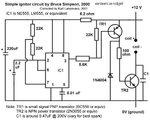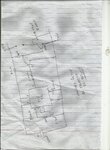RMMK
Full Member level 3

I followed this circuit diagram for making my ignition Circuit and connected it to an ignition coil of a car but it does not produce any spark at the spark plug?? Where do I get it wrong??? Also I didnt had 3 in qty 22000 ohm resistors that is why i used 27000 ohm resistors in place of the two resistors connected at pin 2 of NE555 IC! the other 22000 ohm resistor is correct!
Also I am using a 12V 80 Amps Car battery for powering this circuit!
Plz help me on this!!!! NEED URGENT HELP :evil:

The Ignition Coil is not metal body bottle shaped one......... Its a standard Suzuki Cultus Coil!
When the Coil was connected with my circuit I didnt get ant potential difference w.r.t ground at pin 3...... but pin 4 and pin 8 shows 12 Volts! All I get is around 2 Volts at the base of transistor BC559 that is after 5.6Kohm resistor at pin 3! Even if I disconnect the whole Pin 3 with the 5.6K ohm resistor I am getting No output at Pin3..........
But when I disconnected this Ignition Coil from my circuit....... the Pin 3 showed a potential difference of around 11.86 V! Pin 8 and 4 showed 12.26 Volts!.......This 11.86V reading appears only when the 5.6K ohm resistor is disconnected from pin 3 of 555 IC!
Also with a disconnected Coil around 12 Volts appear at the terminals where coil is supposed to be located! With coil connected it disappears!
I am using a Digital Multimeter to check for voltages!
Also I am using a 12V 80 Amps Car battery for powering this circuit!
Plz help me on this!!!! NEED URGENT HELP :evil:

The Ignition Coil is not metal body bottle shaped one......... Its a standard Suzuki Cultus Coil!
When the Coil was connected with my circuit I didnt get ant potential difference w.r.t ground at pin 3...... but pin 4 and pin 8 shows 12 Volts! All I get is around 2 Volts at the base of transistor BC559 that is after 5.6Kohm resistor at pin 3! Even if I disconnect the whole Pin 3 with the 5.6K ohm resistor I am getting No output at Pin3..........
But when I disconnected this Ignition Coil from my circuit....... the Pin 3 showed a potential difference of around 11.86 V! Pin 8 and 4 showed 12.26 Volts!.......This 11.86V reading appears only when the 5.6K ohm resistor is disconnected from pin 3 of 555 IC!
Also with a disconnected Coil around 12 Volts appear at the terminals where coil is supposed to be located! With coil connected it disappears!
I am using a Digital Multimeter to check for voltages!




